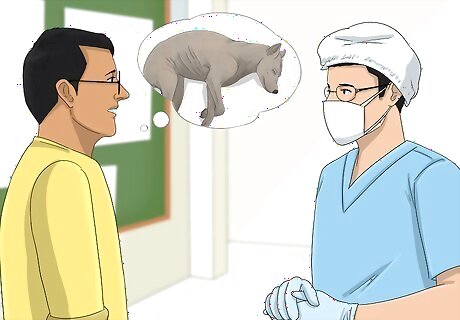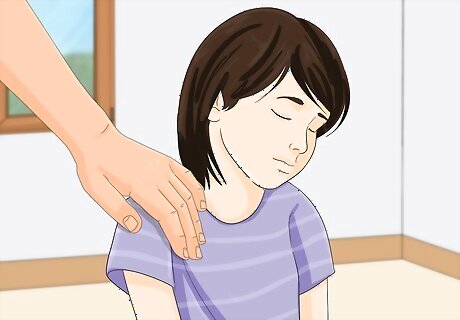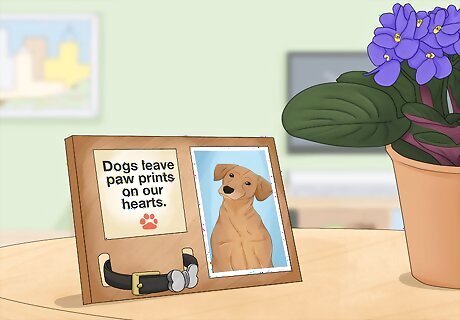
views
Discussing Options with Your Veterinarian

Discuss about the options available for your dog's treatment. Ask questions about your dog's illness, prognosis, and treatment options available. Make sure to write everything down or bring along a friend or family member who will help you remember your options. Your feelings of grief will make it difficult for you to remember everything. If your veterinarian indicates that there may be few or no options that can treat your dog's illness or condition, ask about other options to consider and the costs involved, including the following: Continuing to provide treatment at home and the medications available. Discuss about palliative care to help with pain management and the costs. Putting the dog down in a safe space under direction of a veterinarian. Discuss when and how this is done and the costs involved. Treatment options to prolong life or surgeries needed. Understand the limitations, such as only prolonging a dog's life for a few more months and the possibly of high vet bills.

Assess your dog's quality of life. Use the HHHHMM Quality of Life Scale to assess your dog's health and condition, as indicated in the criteria below. Talk with your vet about what score you believe your dog has in terms of quality of life, and compare this to the score your vet gives. You can also ask other members of your household or close friends and family to provide a score as well. Understand that you may have a biased score (with good reason), due to wishing to have more time with your pet. Think about the following criteria for your pet's quality of life: Hurt Hunger Hydration Hygiene Happiness Mobility More Good Days than Bad

Consider the pros and cons of euthanasia at end of life. While putting your dog down via euthanasia may seem upsetting, think about the reasons why it may be a less painful way for your pet to end their life. Talk with your veterinarian about the pros and cons, as well as your dog's current quality of life: Pros: providing a gentle way to go in a safe and controlled space, having the opportunity to be present when you say good-bye, ensuring that your pet feels no pain at the time of death Cons: feeling possible guilt that you cannot stop your pet from dying, taking on the stressful task of making life and death decisions for your pet Consider filling out this assessment tool created by the Ohio State University Veterinary Medical Center, and discuss it with your veterinarian to understand your dog's current health and quality of life: https://vet.osu.edu/vmc/sites/default/files/import/assets/pdf/hospital/companionAnimals/HonoringtheBond/HowDoIKnowWhen.pdf
Coping During the Final Days or Weeks

Provide a comfortable environment during your dog's end of life. Watching your pet suffer is likely something that causes you great pain and worry. Most likely as you are making the decision to put your dog down, you are continuing to provide as much comfort as possible for your pet. Think about these ways to provide care for your elderly pet to minimize their pain or distress: Ask your veterinarian about comfort medications available to reduce pain or other symptoms related to your pet's illness that lower their quality of life. Provide a quiet and comfortable space at home for your pet. Reduce noise or interactions that could cause stress to your pet. Provide a warm, well-cushioned sleeping spot for your pet as they may have pressure sores, arthritis, or reduced mobility. Monitor issues with incontinence or loss of bladder control. Check for soiling or wetness regularly. Surround your dog with their favorite toys, blanket, and treats to make them comfortable. Try to be home for as long as possible to comfort your dog. If you must be gone for long periods of time, then have a familiar friend or family member check in on them.

Notify family or friends before putting your dog down. You may have relatives, children, or friends that have a close relationship with your pet. Make sure to notify them, and help them if they have questions or are experiencing grief. Make sure to identify someone who can also support you when you decide to put your dog down. Make sure to tell friends and family a few days ahead of time about the plans to put down your dog. This allows them to offer support or make arrangements if they wish to be present at the time of the procedure. While you may be hesitant to tell your children, use this is as a time to help them grapple with loss as a part of life. Consider having a supportive friend or family member join you before or after your dog has been put down to provide additional emotional support for you.

Help your child to cope with grief. If you have a family pet that is adored by your children as well as you, then understand that they need to an opportunity grieve and cope with dying process. Children may have questions and fears related to their dog's death. Help them to process these feelings. Allow your child to express their grief openly. Be respectful of their compassion for their dying pet. Provide reassurance that their pet's death is not their fault or anyone else's. Explain to them, "Dying is simply a part of life. It is a process we must face from time to time. While we can't change it, know that this is not your fault." Allow them to participate in the final moments or afterwards if they wish to be present. Be a support for them, and help them to understanding this difficult time. Consider words of support such as, "I know that this is tough. He was such as sweet and loveable dog. Let's help each other through this, okay?" Try reading books to your children to help the understand and cope with their feelings, such as ‘’I'll Always Love You’’ by Hans Wilhelm. If the child is able to read, have them read it.

Saying good-bye in the final moments. Use this time to find some closure. While you can't stop your pet from aging and passing away, you can find some meaning and acceptance in the process of death and dying. It reminds us to use these precious moments wisely and thoughtfully. Give your pet the love and support that they need in their final moments. Provide lots of physical affection, such as by petting them and snuggling them. Use this as a time to let go of the past, and be a supportive presence. Talk with your pet. Say what you need to say to find meaning and closure. Know that you don't have to be present in the final moments. It may be hard to be present a few moments before your pet is put to sleep. Know that the act of saying-goodbye can be different for everyone.
Grieving After Your Dog is Put Down

Consider burial or cremation options. For many people, their dogs can be like close family. Talk with your veterinarian or other community resources about burial or cremation options that feel right for you. Some people wish to provide a burial for their pets, either at a pet cemetery or possibly on their own property. Understand that each person and family is different. You may not wish to bury or cremation your pet, and that's okay too. Review the costs and planning involved with burial or cremation. If this is a family dog, make sure to get input from all the family members about their preferences.

Honor your pet's memory. There are many ways to honor your dog's memory that can be respectful and cathartic. While some people simply keep the memory alive through photo albums and small keepsakes, others may wish to hold memorial services for their pet. Do what feels right for you. Consider these ways to honor their memory: Create a photo album of your pet. Add some memorabilia items of your pet such as a collar or toys to go with the photo album. Create a small vigil in your home after your pet's death using photos and candles. Light a candle to honor their memory. Have a small memorial service at your pet's grave site if buried. Share memories of your pet with friends and family, including silly stories, heartwarming moments, and cute photos. Plant a tree or flowers in their honor. Donate any of their old toys, bed, or other items that are in good condition to a dog shelter.

Reach out for support in times of grief. Remember that you are not alone in your feelings of grief, loss, and guilt. Death, particularly the act of putting down a pet, can be difficult. You may feel regret that you could not do more to help them. Find support to help you with these feelings of grief. Talk with supportive friends and family who can help you through this time. Identify pet loss support through counselors or local support groups in your community via the Association for Pet Loss and Bereavement: http://www.aplb.org/support/ Find online support through pet loss chat rooms via Rainbow's Bridge: http://www.rainbowsbridge.com/ Find grief support and resources via ASPCA's Pet Loss Hotline: 877-GRIEF-10 (877-474-3310)

Identify healthy self-coping strategies after loss. Accept your feelings as they are and allow yourself plenty of time to grieve. Don’t shame yourself if grieving the loss of your pet takes longer than you expected. This is just a reflection of the special relationship you had with your dog. Don't let anyone tell you how to feel. Your loss is your own. Instead, take healthy steps to stay well in mind and body. Consider these positive ways to self-cope: Get plenty of rest and sleep. Exercise regularly. Join a fitness class or group. Eat healthy. Make nutritious and delicious meals for yourself. If you have other pets, keep the routine consistent. They may feel sorrow as well when your dog passes. Give them extra love and attention. Keep up with their daily routines.

















Comments
0 comment